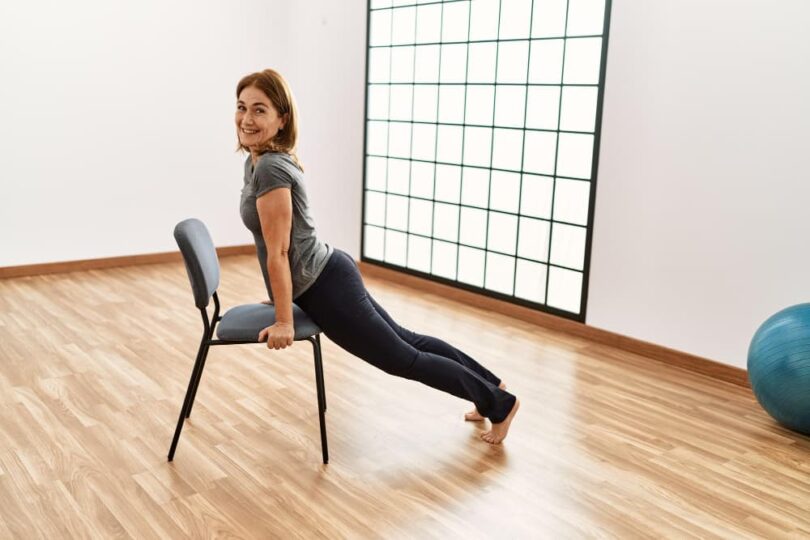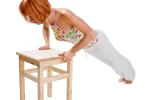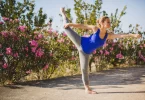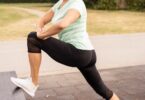Introduction
Chair yoga is a gentle form of yoga practiced while seated or using a chair for support. It’s perfect for those with mobility issues, seniors, or anyone looking for a low-impact workout. This article will guide you through the benefits, poses, and routines of chair yoga, helping you to incorporate this accessible practice into your daily life.
Table of Contents
Introduction to Chair Yoga
Chair yoga is a versatile and inclusive form of yoga designed to be practiced while seated or with the support of a chair. Whether you’re dealing with limited mobility, recovering from an injury, or simply looking for a new way to relax at your desk, chair yoga offers a gentle yoga option that fits into various lifestyles. This practice makes yoga accessible to everyone, regardless of age, flexibility, or physical condition.
Chair yoga originated as a way to make yoga more accessible, allowing more people to experience the benefits of this ancient practice. Unlike traditional yoga, chair yoga poses are modified to be performed sitting in a chair or standing while holding onto the chair for support. This allows for a wide range of movements that help improve flexibility, strength, and mental well-being.
Benefits of Chair Yoga
Physical Benefits
One of the primary benefits of chair yoga is improved flexibility. Regular practice helps loosen tight muscles and increase your range of motion. This is particularly beneficial for those who spend a lot of time sitting at a desk or have limited mobility.
Increased strength is another key benefit. Chair yoga poses engage various muscle groups, helping to build strength in a gentle yet effective way. This can lead to better posture and reduced risk of injury.
Better posture is a common result of regular chair yoga practice. Many of the poses focus on aligning the spine and strengthening the core, which can alleviate common issues like back pain and poor posture from prolonged sitting.
Mental Benefits
Chair yoga is also great for mental well-being. It can significantly reduce stress by promoting relaxation and mindfulness. The gentle movements combined with deep breathing help calm the mind and body, making it an excellent practice for reducing anxiety and stress.
Enhanced focus and concentration are other mental benefits of chair yoga. By requiring you to pay attention to your body and breath, chair yoga helps improve your ability to concentrate and stay present in the moment.
Improved mood is another advantage. The combination of physical activity, deep breathing, and mindfulness can lead to a boost in endorphins, the body’s natural mood lifters.
Benefits for Specific Populations
Chair yoga is particularly beneficial for seniors. As we age, maintaining physical activity can become more challenging. Chair yoga provides a safe and effective way for seniors to stay active, improve flexibility, and maintain their independence. For more detailed information on chair yoga specifically for seniors, check out this free guide to enhanced well-being.
Office workers can also benefit greatly from chair yoga. Sitting at a desk for long periods can lead to stiffness and discomfort. Chair yoga offers a convenient way to stretch and strengthen muscles without leaving your workspace.
People with limited mobility, whether due to injury, disability, or other reasons, will find chair yoga to be a wonderful practice. It allows them to engage in physical activity safely and comfortably, helping to improve their overall health and well-being.
Getting Started with Chair Yoga
Equipment Needed
To start practicing chair yoga, you’ll need a sturdy chair without arms, preferably one that allows your feet to rest flat on the floor. This type of chair provides the necessary support and stability for the poses.
Additional accessories, such as yoga blocks or straps, can also be helpful. These tools assist with modifications and make poses more accessible, especially for those with limited flexibility.
Basic Guidelines
Before beginning your chair yoga session, it’s essential to prepare properly. Wear comfortable clothing that allows for a full range of motion. Find a quiet space where you won’t be disturbed, and ensure your chair is on a stable surface to prevent slipping.
Safety tips and precautions are crucial to keep in mind. Always listen to your body and avoid pushing yourself too hard. If you feel any pain, stop immediately and adjust the pose. It’s also a good idea to consult with a healthcare professional before starting any new exercise program, especially if you have any pre-existing conditions.
For more detailed guidelines on starting chair yoga, you can refer to this resource.
Chair Yoga Poses
Chair yoga offers a variety of poses that can be done while seated or using a chair for support. These poses are designed to help you gain flexibility, build strength, and find relaxation, all without leaving your chair.
Warm-Up Poses
Seated Cat-Cow Stretch
The Seated Cat-Cow Stretch is a gentle way to warm up your spine. Sit comfortably on your chair with your feet flat on the floor. Place your hands on your knees. As you inhale, arch your back and look up towards the ceiling (Cow Pose). As you exhale, round your spine and tuck your chin towards your chest (Cat Pose). Repeat this sequence for several breaths to loosen up your back and improve your posture.
Seated Mountain Pose
Seated Mountain Pose helps you find alignment and stability. Sit up straight with your feet flat on the floor. Place your hands on your thighs with your palms facing down. Engage your core and lengthen your spine. Roll your shoulders back and down, and reach the top of your head towards the ceiling. Hold this position for a few breaths, focusing on your posture and breathing deeply.
Main Poses
Seated Forward Bend
The Seated Forward Bend stretches your hamstrings and lower back. Sit on the edge of your chair with your feet hip-width apart. Inhale and lengthen your spine. As you exhale, hinge at your hips and fold forward, reaching your hands towards your feet or the floor. Keep your back straight and avoid rounding your spine. Hold this pose for a few breaths, then slowly return to an upright position.
Seated Twist
The Seated Twist helps release tension in your spine and improves flexibility. Sit up straight with your feet flat on the floor. Place your right hand on the back of the chair and your left hand on your right knee. Inhale to lengthen your spine, and as you exhale, twist to the right, looking over your right shoulder. Hold this pose for a few breaths, then return to the center and repeat on the other side.
Seated Eagle Arms
Seated Eagle Arms stretch the shoulders and upper back. Sit up straight with your feet flat on the floor. Extend your arms forward at shoulder height and cross your right arm over your left, bringing your palms together if possible. Lift your elbows slightly and hold this position for a few breaths. Switch arms and repeat on the other side.
Seated Warrior Pose
Seated Warrior Pose strengthens the legs and improves balance. Sit sideways on your chair with your left thigh on the seat and your right leg extended to the side. Bend your right knee and plant your foot firmly on the ground. Extend your arms out to the sides at shoulder height. Hold this pose for a few breaths, then switch sides and repeat.
For a more detailed guide to these poses, you can visit this resource.
Cool Down Poses
Seated Savasana
Seated Savasana helps you relax and unwind. Sit comfortably on your chair with your feet flat on the floor and your hands resting on your thighs. Close your eyes and take slow, deep breaths. Focus on releasing any tension in your body and quieting your mind. Stay in this position for a few minutes, enjoying the peace and calm.
Seated Neck Stretches
Seated Neck Stretches relieve tension in the neck and shoulders. Sit up straight with your feet flat on the floor. Slowly tilt your head to the right, bringing your right ear towards your right shoulder. Hold this stretch for a few breaths, then switch sides. You can also gently turn your head to look over each shoulder for a deeper stretch.
Chair Yoga Routines
Chair yoga routines are designed to fit into your daily schedule, whether you have just a few minutes or half an hour. These routines can be done at home, in the office, or anywhere you have a chair. Let’s break down routines for beginners, intermediate, and advanced practitioners.
Beginner Routine
10-Minute Routine
- Seated Mountain Pose (1 minute)
- Sit up straight with feet flat on the floor. Place hands on your thighs, engage the core, and lengthen your spine. Breathe deeply.
- Seated Cat-Cow Stretch (2 minutes)
- Place hands on knees. Inhale, arch your back, and look up (Cow Pose). Exhale, round your spine, and tuck your chin (Cat Pose). Repeat for several breaths.
- Seated Forward Bend (2 minutes)
- Sit on the edge of the chair. Inhale to lengthen the spine, exhale to hinge at the hips, and reach towards your feet. Hold and breathe.
- Seated Twist (2 minutes)
- Place your right hand on the back of the chair and your left hand on the right knee. Inhale to lengthen the spine, and exhale to twist to the right. Hold for a few breaths, then switch sides.
- Seated Neck Stretches (1 minute)
- Slowly tilt your head to the right, bringing your ear towards your shoulder. Hold, then switch sides.
- Seated Savasana (2 minutes)
- Sit comfortably, close your eyes, and take deep breaths. Focus on relaxing and releasing tension.
Intermediate Routine
20-Minute Routine
- Seated Mountain Pose (2 minutes)
- Sit up straight with feet flat on the floor. Place hands on your thighs, engage the core, and lengthen your spine. Breathe deeply.
- Seated Cat-Cow Stretch (3 minutes)
- Place hands on knees. Inhale, arch your back, and look up (Cow Pose). Exhale, round your spine, and tuck your chin (Cat Pose). Repeat for several breaths.
- Seated Forward Bend (3 minutes)
- Sit on the edge of the chair. Inhale to lengthen the spine, exhale to hinge at the hips, and reach towards your feet. Hold and breathe.
- Seated Twist (3 minutes)
- Place your right hand on the back of the chair and your left hand on the right knee. Inhale to lengthen the spine, and exhale to twist to the right. Hold for a few breaths, then switch sides.
- Seated Eagle Arms (3 minutes)
- Extend arms forward at shoulder height, cross right arm over left, bring palms together. Lift elbows slightly. Hold, then switch arms.
- Seated Warrior Pose (4 minutes)
- Sit sideways on the chair with left thigh on the seat, right leg extended to the side. Bend right knee, plant foot on the ground. Extend arms out to the sides. Hold, then switch sides.
- Seated Savasana (2 minutes)
- Sit comfortably, close your eyes, and take deep breaths. Focus on relaxing and releasing tension.
Advanced Routine
30-Minute Routine
- Seated Mountain Pose (2 minutes)
- Sit up straight with feet flat on the floor. Place hands on your thighs, engage the core, and lengthen your spine. Breathe deeply.
- Seated Cat-Cow Stretch (4 minutes)
- Place hands on knees. Inhale, arch your back, and look up (Cow Pose). Exhale, round your spine, and tuck your chin (Cat Pose). Repeat for several breaths.
- Seated Forward Bend (4 minutes)
- Sit on the edge of the chair. Inhale to lengthen the spine, exhale to hinge at the hips, and reach towards your feet. Hold and breathe.
- Seated Twist (4 minutes)
- Place right hand on the back of the chair, left hand on the right knee. Inhale to lengthen the spine, exhale to twist to the right. Hold for a few breaths, then switch sides.
- Seated Eagle Arms (4 minutes)
- Extend arms forward at shoulder height, cross right arm over left, bring palms together. Lift elbows slightly. Hold, then switch arms.
- Seated Warrior Pose (6 minutes)
- Sit sideways on the chair with left thigh on the seat, right leg extended to the side. Bend right knee, plant foot on the ground. Extend arms out to the sides. Hold, then switch sides.
- Seated Neck Stretches (2 minutes)
- Slowly tilt your head to the right, bringing your ear towards your shoulder. Hold, then switch sides.
- Seated Savasana (4 minutes)
- Sit comfortably, close your eyes, and take deep breaths. Focus on relaxing and releasing tension.
These routines provide a structured approach to chair yoga, catering to different levels of experience and time availability. By practicing regularly, you can enjoy the numerous benefits of chair yoga, whether you’re a beginner or an advanced practitioner.
FAQs About Chair Yoga
Is chair yoga any good for weight loss?
Chair yoga can contribute to weight loss by increasing physical activity, improving muscle tone, and boosting metabolism. While it might not burn as many calories as more intense forms of exercise, it still helps you stay active and can be a valuable part of a weight loss plan. Combining chair yoga with a balanced diet and other forms of exercise can lead to better results. Additionally, chair yoga reduces stress, which can help prevent stress-related eating.
Is chair yoga difficult?
Chair yoga is designed to be accessible to everyone, regardless of fitness level or age. The poses are modified to be easier to perform while seated or using a chair for support. This makes it less challenging than traditional yoga. However, like any new activity, it can take some time to get used to the movements and build strength and flexibility. The key is to listen to your body, go at your own pace, and practice regularly.
What is the purpose of chair pose in yoga?
The chair pose, or Utkatasana, is a powerful pose that strengthens the legs, back, and core muscles. It also improves balance and stability. When performed as a chair yoga pose, it allows individuals who may not be able to stand or balance independently to still engage these muscle groups effectively. The chair pose helps in building endurance and can also increase heart rate, contributing to cardiovascular health.
Is chair yoga only for seniors?
Chair yoga is not only for seniors. While it is particularly beneficial for older adults due to its gentle nature and low impact, it is also suitable for people of all ages and fitness levels. Office workers, individuals with mobility issues, and anyone looking for a gentle form of exercise can benefit from chair yoga. It offers a way to practice yoga that is accessible and adaptable, making it a great option for a wide range of people.
Conclusion
Chair yoga offers a wonderful way to stay active, flexible, and mentally balanced, regardless of your age or physical condition. This gentle practice can be easily integrated into your daily routine, providing a range of physical and mental benefits.
From improving flexibility and strength to reducing stress and enhancing focus, chair yoga is a versatile form of exercise. It caters to everyone, from seniors to office workers and anyone with limited mobility. By incorporating chair yoga poses and routines, you can enjoy a healthier, more balanced life.
If you’ve been hesitant to try yoga due to mobility issues or time constraints, chair yoga is an excellent starting point. Its accessibility and adaptability make it a perfect choice for anyone looking to add a mindful movement practice to their life.
Give chair yoga a try and experience the positive changes it can bring to your overall well-being. Whether you’re looking to ease tension from a long day at the office or seeking a gentle way to stay active, chair yoga offers something for everyone.







